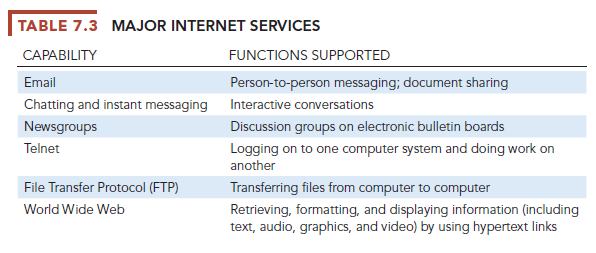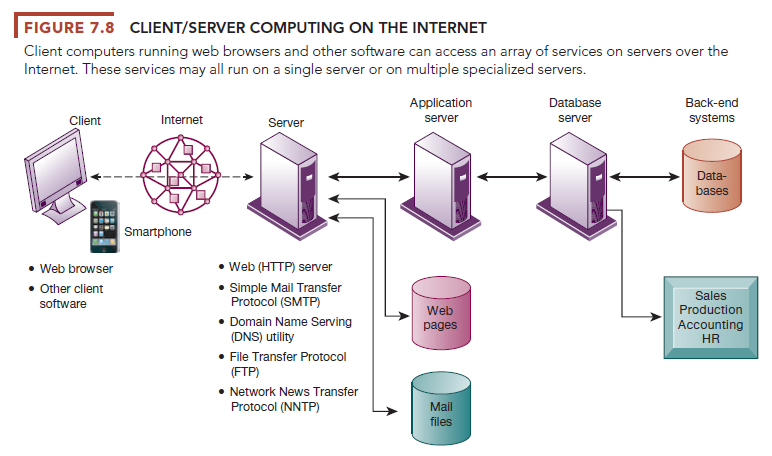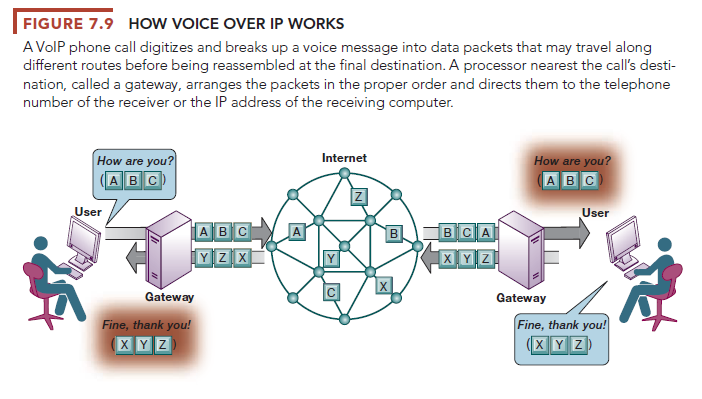The Internet is based on client/server technology. Individuals using the Internet control what they do through client applications on their computers, such as web browser software. The data, including email messages and web pages, are stored on servers. A client uses the Internet to request information from a particular web server on a distant computer, and the server sends the requested information back to the client over the Internet. Client platforms today include not only PCs and other computers but also smartphones and tablets.
1. Internet Services
A client computer connecting to the Internet has access to a variety of services. These services include email, chatting and instant messaging, electronic discussion groups, Telnet, File Transfer Protocol (FTP), and the web. Table 7.3 provides a brief description of these services.
Each Internet service is implemented by one or more software programs. All the services may run on a single server computer, or different services may be allocated to different machines. Figure 7.8 illustrates one way these services can be arranged in a multitiered client/server architecture.
Email enables messages to be exchanged from computer to computer, with capabilities for routing messages to multiple recipients, forwarding messages, and attaching text documents or multimedia files to messages. Most email today is sent through the Internet. The cost of email is far lower than equivalent voice, postal, or overnight delivery costs, and email messages can arrive anywhere in the world in a matter of seconds.
Chatting enables two or more people who are simultaneously connected to the Internet to hold live, interactive conversations. Chat systems now support voice and video chat as well as written conversations. Many online retail businesses offer chat services on their websites to attract visitors, to encourage repeat purchases, and to improve customer service.
Instant messaging is a type of chat service that enables participants to create their own private chat channels. The instant messaging system alerts the user whenever someone on his or her private list is online so that the user can initiate a chat session with other individuals. Instant messaging systems for consumers include Yahoo! Messenger, Google Hangouts, AOL Instant Messenger, Facebook Messenger. Companies concerned with security use proprietary communications and messaging systems such as IBM Sametime.


Newsgroups are worldwide discussion groups posted on Internet electronic bulletin boards on which people share information and ideas on a defined topic such as radiology or rock bands. Anyone can post messages on these bulletin boards for others to read.
Employee use of email, instant messaging, and the Internet is supposed to increase worker productivity, but the accompanying Interactive Session on Management shows that this may not always be the case. Many company managers now believe they need to monitor and even regulate their employees’ online activity, but is this ethical? Although there are some strong business reasons companies may need to monitor their employees’ email and web activities, what does this mean for employee privacy?
2. Voice over IP
The Internet has also become a popular platform for voice transmission and corporate networking. Voice over IP (VoIP) technology delivers voice information in digital form using packet switching, avoiding the tolls charged by local and long-distance telephone networks (see Figure 7.9). Calls that would ordinarily be transmitted over public telephone networks travel over the corporate network based on the Internet protocol, or over the public Internet. Voice calls can be made and received with a computer equipped with a microphone and speakers or with a VoIP-enabled telephone.
Cable firms such as Time Warner and Cablevision provide VoIP service bundled with their high-speed Internet and cable offerings. Skype offers free VoIP worldwide using a peer-to-peer network, and Google has its own free VoIP service.
Although up-front investments are required for an IP phone system, VoIP can reduce communication and network management costs by 20 to 30 percent. For example, VoIP saves Virgin Entertainment Group $700,000 per year in long-distance bills. In addition to lowering long-distance costs and eliminating monthly fees for private lines, an IP network provides a single voice-data infrastructure for both telecommunications and computing services. Companies no longer have to maintain separate networks or provide support services and personnel for each type of network.

3. Unified Communications
In the past, each of the firm’s networks for wired and wireless data, voice communications, and videoconferencing operated independently of each other and had to be managed separately by the information systems department. Now, however, firms can merge disparate communications modes into a single universally accessible service using unified communications technology. Unified communications integrates disparate channels for voice communications, data communications, instant messaging, email, and electronic conferencing into a single experience by which users can seamlessly switch back and forth between different communication modes. Presence technology shows whether a person is available to receive a call.
CenterPoint Properties, a major Chicago area industrial real estate company, used unified communications technology to create collaborative websites for each of its real estate deals. Each website provides a single point for accessing structured and unstructured data. Integrated presence technology lets team members email, instant message, call, or videoconference with one click.
4. Virtual Private Networks
What if you had a marketing group charged with developing new products and services for your firm with members spread across the United States? You would want them to be able to email each other and communicate with the home office without any chance that outsiders could intercept the communications. Large private networking firms offer secure, private, dedicated networks to customers, but this is expensive. A lower-cost solution is to create a virtual private network within the public Internet.
A virtual private network (VPN) is a secure, encrypted, private network that has been configured within a public network to take advantage of the economies of scale and management facilities of large networks, such as the Internet (see Figure 7.10). A VPN provides your firm with secure, encrypted communications at a much lower cost than the same capabilities offered by traditional non-Internet providers that use their private networks to secure communications. VPNs also provide a network infrastructure for combining voice and data networks.
Several competing protocols are used to protect data transmitted over the public Internet, including Point-to-Point Tunneling Protocol (PPTP). In a process called tunneling, packets of data are encrypted and wrapped inside IP packets. By adding this wrapper around a network message to hide its content, business firms create a private connection that travels through the public Internet.
Source: Laudon Kenneth C., Laudon Jane Price (2020), Management Information Systems: Managing the Digital Firm, Pearson; 16th edition.

A person essentially lend a hand to make severely articles I might state.
That is the first time I frequented your website page and to this
point? I surprised with the analysis you made to make this actual submit incredible.
Excellent task!
Saved as a favorite, I love your site!
Highly energetic article, I loved that a lot. Will there be a part 2?